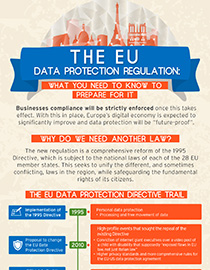The Road to Compliance: A Visual Guide to the EU Data Protection Law
 View infographic: The EU Data Protection Regulation
View infographic: The EU Data Protection Regulation
In 2015, 28 European member states are set to start implementing a new set of data protection laws using a directive that will seek to define personal data, apply sanctions for breaches, respect the public’s right to be forgotten, and more. Because of this, enterprises are now caught scrambling to foresee how this would affect the way they do business, especially in terms of how they handle customer information.
In its site, the European Commission points out that everyone has the right to the protection of personal data. This is especially important these days, as personal data loss and data breach incidents continue to pile up. A recent research on data breach incidents in Europe found that people lost some 645 million personal records from 2005 to 2014. However, despite the din of media coverage discussing data breach and personal privacy, it was also found that over a third (36%) of citizens from Europe aren't even aware of the EU Data Protection Regulation.
The new rules trace back to a data protection directive in 1995 and amendments in the following years. They follow changes made after high-profile events and call out for higher privacy standards given existing data protection regulations.
The new data protection laws integrate the “right to be forgotten,” which was strengthened by a positive ruling during the second quarter of 2014. This allows users to request for search engines to remove search results related to them on search results. In addition, businesses will be required to explicitly ask for consent when processing data, instead of just assuming that the user agrees to it. Breaches will stop being secret to customers as the new regulations dictates that a notification must be made within 24 hours after a breach has happened.
Lawmakers maintain that once the new regulations take effect, Europe’s digital economy is expected to significantly improve and data protection will be “future-proof.” This considers digital challenges that may arise from the rapidly changing technological landscape in Europe. These challenges may arise from personal information transmitted via cloud computing, increasing online disclosures of personal data to sites, as well as continued adoption of online payments and other technological advancements.
Learn how you can get your organization ready for the new EU data protection regulations by viewing the embedded infographic: The EU Data Protection Regulation

Like it? Add this infographic to your site:
1. Click on the box below. 2. Press Ctrl+A to select all. 3. Press Ctrl+C to copy. 4. Paste the code into your page (Ctrl+V).
Image will appear the same size as you see above.
 Cellular IoT Vulnerabilities: Another Door to Cellular Networks
Cellular IoT Vulnerabilities: Another Door to Cellular Networks AI in the Crosshairs: Understanding and Detecting Attacks on AWS AI Services with Trend Vision One™
AI in the Crosshairs: Understanding and Detecting Attacks on AWS AI Services with Trend Vision One™ Trend 2025 Cyber Risk Report
Trend 2025 Cyber Risk Report CES 2025: A Comprehensive Look at AI Digital Assistants and Their Security Risks
CES 2025: A Comprehensive Look at AI Digital Assistants and Their Security Risks